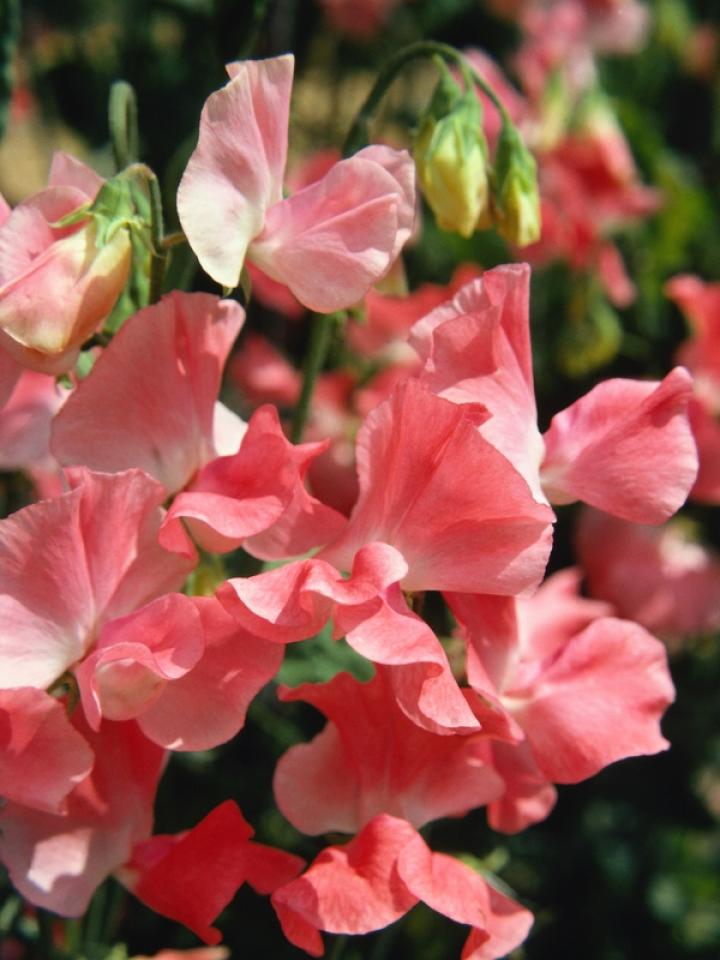
Sweet peas enchant us with their fragile, seductive fragrance and make great bouquets. These pea-like flowers grow in many lovely colors and are suitable for an annual border, a woodland garden, and a trellis or arch.
Sweet Pea
(Delicate Pleasures)
“Here are sweet peas,on tip-toe for a flight
With wings of gentle flusho’er delicate white,
And taper fingers catchingat all things
To bind them all aboutwith tiny rings.”
–John Keats (1795–1821)
Cultivated sweet peas go back at least 300 years. In their native Sicily, these ornamental peas have weak stems and intense orange-jasmine-honey scent. Modern hybrids are stronger-stalked and have larger blooms.
Growing sweet peas is akin to making piecrust. Some people have the knack, others don’t. Sweet peas are quite hardy, growing from large, easy-to-handle pea-like seeds. Still, they’re a bit tricky because they are slow to germinate. It’s worth experimenting with different seeds each year.
Planting
- Early sowing is one of the secrets of sweet peas. In Zone 7 or colder, plant them in very late winter or early spring as soon as the soil is dry enough to work. (Do not wait until frost.) In the coldest parts of the country, get a jump on the season by starting sweet peas indoors in six-packs or Jiffy pots. Harden seedlings off for at least a week, and then set them out into the garden as soon as the soil can be worked. If you garden in mild winter climates (Zones 8, 9, or 10), plant sweet peas in the late fall so they can develop and bloom in late winter and early spring.
- Sweet peas are happiest with their heads in the sun and their roots deep in cool, moist soil. When possible, plant low-growing annuals in front of them to shade their roots.
- Choose a well-drained site. Alkaline soil is best; sprinkle some powdered lime on the surface if your soil tends to be acidic.
- Prepare a rich soil by mixing in generous amounts of compost and well-rotted manure mixed to a depth of 2 feet.
- Prior to planting, you’re going to want to dig a nice deep trench of about 4 inches in depth.
- After you dig the trench, make holes with a pencil, drop in the seeds, and press down on the soil to firm it and shut out any light.
- Before planting, soak the seeds in water for 24 hours. Then nick the seeds with a nail file before planting to speed sprouting. You do not need to soak seeds in a temperate climate.
Care
- Once planted, germination can take 7 to 15 days, depending on the soil temperature.
- As seedlings emerge and grow, gradually fill in the trench. Hoe more soil up to them.
- Keep soil moist. Summer rain may be ample. If you put your finger into the soil bed to its first joint and the soil is dry: water them at the soil level and do in the morning; sweet peas can suffer from bud drop.
- If you use plenty of aged manure and compost when planting, you do not need to fertilize. If you do want to add nourishment, use high potash feeds, as nitrogen feeds encourage too much top growth.
- Sweet peas prefer cool days and nights and will start to fade when temperatures go above 65 degrees F.
- Except for the bush types, sweet peas are real climbers. Give them at least 6 feet of good support. Some varieties may climb to 9 or 1 feet. If you don’t have a fence or trellis, provide brush or chicken wire or bushy stubbly twigs that they can cling to.
- When plants become established, mulch well to keep the soil cool and moist. If you mulch, you may not need to water your sweet peas unless the soil gets dry.
- To encourage bushy growth, pinch off the tops when plants are 6 inches tall, not before or you’ll encourage premature side-shoot development.
- Pick the flowers for bouquets often and the plant will put energy into more blooms instead of going to seed. Harvest the stems when the lowest blossom is just begining to open.
Pests/Diseases
- Slugs and snails may attack young growth.
- Pythium root rot, powdery mildew, rust, gray mold, and various leaf spots are common.
Recommended Varieties
- ‘April in Paris’ is a fragrant modern variety with large creamy-yellow blossoms and lilac shading.
- The deliciously scented ‘America’ is an heirloom, dating to 1896. Its petals unfurl to show stunning wavy red and white stripes.
- Breeders now often varieties with old-fashioned perfume as well as heat resistance. Look for heirlooms like the ‘Old Spice’ collection from Sicily. This strain blooms in shades of white, cream, pink, lavender, and purple.
Wit & Wisdom
- The sweet pea is essential member of a late-Victorian garden. Victorians loved sweet peas for their coor diversity and fragrance.
- Gather the flowers in the morning when the dew is still on them. This is when their scent is the sweetest.
- Sweet peas are one of the April birth flowers.
“The odor of the sweet pea is so offensive to flies that it will drive them out of a sick-room, though not in the slightest degree disagreeable to the patient.”
–A tip from The 1899 Old Farmer’s Almanac






